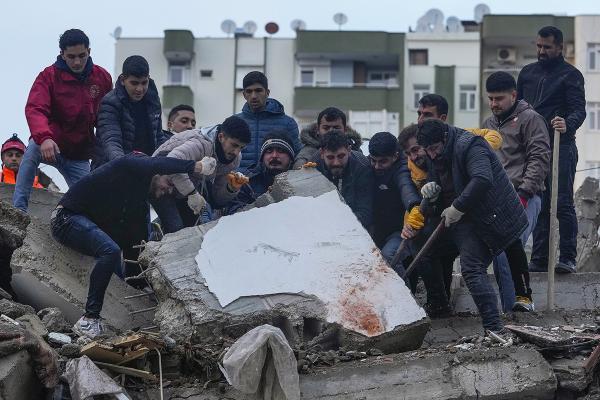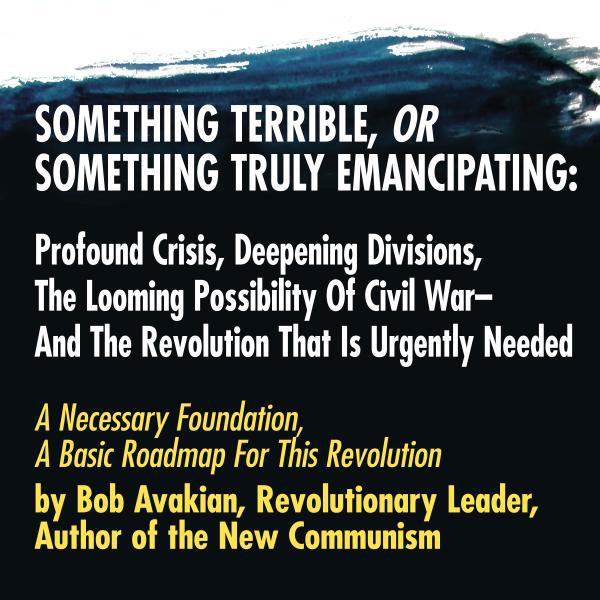Update, February 19—Last week revcom.us reported on the devastating earthquake that struck Turkey and Syria on February 6 (see below). We drew out the role of the system of capitalism-imperialism, and governments and leaders tied to that system, in bringing about a whole other—and unnecessary—level of death and suffering from this natural disaster. Since then, the scale of this has become even more staggering:
The death toll mounts daily. As of February 18, over 46,000 deaths have been confirmed: 40,642 in Turkey, and nearly 6,000 in Syria. Neither Turkey nor Syria has estimated the number still missing nor the number injured.
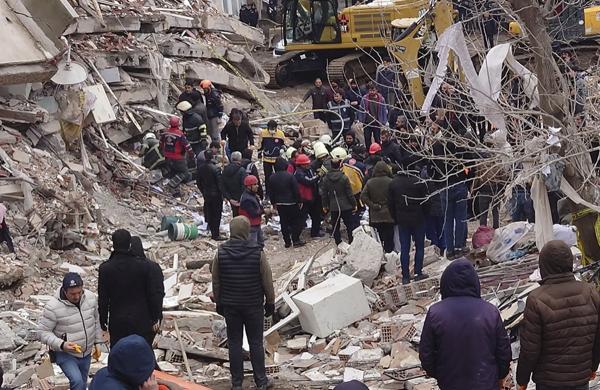
Turkish civilians work with rescue workers to search for survivors under the rubble of a collapsed building in southeastern Turkey, February 6, 2023. Photo: AP
A devastating earthquake hit southern Turkey and northern Syria on Monday, February 6, around 4 am local time. Hundreds of thousands who were lucky enough to be awakened by the initial shaking jumped from their beds, grabbed their kids and ran out into the freezing winter streets, in nightclothes and shoeless. Tens of thousands of others didn’t have time to get out and were crushed or trapped as 6,000-7,000 buildings in Turkey alone collapsed. Many multistory apartments “pancaked,” with each floor collapsing onto the one below, leaving no space for people trapped between them to survive.
As of Sunday, over 34,000 people have been confirmed dead in the two countries, a figure that is likely to grow substantially as more ruins are searched. (In Syria —which has received scarcely any international aid so far—only five percent of collapse sites had been searched as of Thursday.) Tens of thousands of people have also been injured, many severely. And the healthcare system is completely overwhelmed—many hospitals and clinics were damaged and lack utilities, basic medical supplies, and sufficient beds and doctors.
On top of the immediate deaths and injuries, an enormous humanitarian crisis is unfolding. Thousands of homes, though still standing, have structural damage such that people dare not return to them. Many hundreds of thousands of people are suddenly homeless in the dead of winter, living in tents, cars, mosques, stadiums or simply on the street, without heat or electricity, with precious little food or safe water. The UN is warning of the danger of outbreaks of epidemic diseases like cholera due to the terrible hygienic conditions and lack of clean water.
An estimated 23 million people across 10 provinces in Turkey, a dozen cities, and vast rural areas, have been affected by the quake. And several million of these people are Syrian refugees, displaced by a 12-year-long civil war, which is in fact a proxy war between major imperialist powers (the U.S. and Russia) as well as regional powers (Iran, Turkey, Saudi Arabia) over control of Syria. These people were already living on the edge, often in refugee camps and dependent on humanitarian assistance. Now their situation has become extremely precarious.
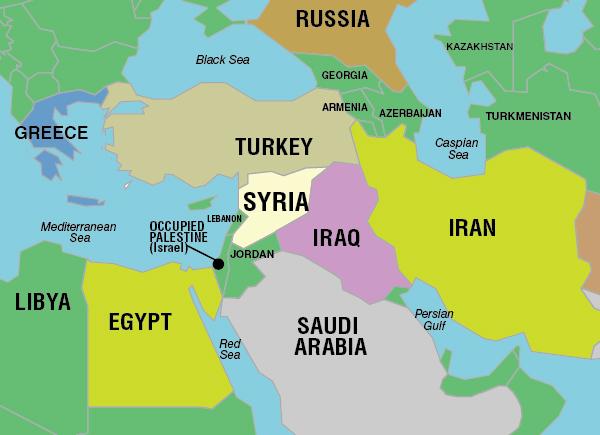
Response of Turkey’s Fascist Government
Turkey’s government is headed by a fascist president, Recep Erdoğan. Erdoğan’s first major act on the day of the quake was to declare a three-month state of emergency. This allows the government to “limit fundamental rights and freedoms,” establish curfews and travel bans, and order compulsory work assignments for civil servants. He immediately mobilized 3,500 military personnel to go to the quake zone. On Wednesday, Twitter access was sharply curtailed, apparently at the request of the government, seriously disrupting relief efforts being coordinated via Twitter. On Thursday, police announced that they had “detained” 31 people and “arrested” nine for “provocative posts about the earthquake on social media platforms.”
Many observers noted that the last time Erdoğan declared a “three-month” state of emergency—in 2016—it ended up lasting two years. During that time, over 100,000 people were arrested and the civil service was purged of 150,000 employees who the regime deemed insufficiently loyal. Many also commented that the presidential elections are scheduled for May, making it easy enough for Erdoğan to extend the state of emergency and postpone the election if it looks like he is going to lose.
For the rulers of an oppressive system, the main danger in this disaster was that they would lose control of the masses of people.
AWOL in Organizing Relief Efforts
As to the danger the masses faced, and the urgent and desperate struggle to save as many people as possible, the government was basically AWOL in the crucial first few days. Overwhelmingly, rescue operations were carried out by the masses of people, often working with their bare hands for 20 or 30 hours straight. Shipments of food, medical supplies and other urgent needs were close to nonexistent. This is in spite of the fact that Turkish government collected at least $4 billion over the last two decades from a special tax that was supposed to fund earthquake preparations!
In Pazarcik Township near the epicenter of the quake, a resident told Arti TV: “We have a village with 350 homes; 90% are destroyed. People are hungry and thirsty. We called the police and [the state-run disaster relief agency] AFAD but nobody has come so far. We have at least 30 of our people trapped under the rubble. The gendarmerie told us ‘make do with your own means.’”
Diyarbakir is a city of about 1.6 million people. A Sky News reporter described how there was massive death and destruction there but only a couple of pieces of digging equipment available. He added, “The rescue effort is a do-it-yourself collection of people. City workers, and members of the fire department, but no specialist search and rescue officials.”1
Similar scenes played out across the earthquake zone. Everywhere, the piles of rubble that were once homes were surrounded by hundreds of people waiting in agony, hoping that their child, their mother, their brother, or other loved ones would be found alive, even as they themselves were suffering terribly from exposure, hunger and thirst. Anger against the government is reportedly mounting.
Erdoğan’s response to this incredible suffering was blasé: “Of course, the first day we had some discomforts,” but after that everything was “under control.”
As to the international rescue teams that got a lot of media coverage, most of them only began to arrive on Wednesday, and generally in token numbers.2 The European and U.S. teams do have skills, knowledge, equipment and trained dogs that are very helpful, but they cannot raise the dead—and 10s of thousands of quake victims did not survive three days, crushed under rubble, in bedclothes in freezing weather, without food or water. Thus this “international aid”—along with pledges of future financial help—are basically a drop in the bucket.3
Earthquakes Can’t Be Prevented, but They Can Be—but Weren’t—Prepared For
This was a powerful earthquake, measuring 7.8 on the Richter scale. And it was followed that afternoon by a 7.5 aftershock. To get a rough idea of how strong this was, the 2010 Haiti earthquake that killed several hundred thousand people measured 7.0 on the Richter scale.
At this point, humanity cannot predict exactly, much less prevent, earthquakes. But the science exists to prepare for them in various ways so as to dramatically lessen the immediate destruction and the ensuing suffering. Turkey has two major earthquake faults that make it “one of the most seismically active regions in the world.” It had a major quake in 1999 that killed around 17,000 people, and others since then. So this latest quake was not a “surprise.”
There are measures that need to be taken in earthquake zones—buildings can be constructed so as to prevent collapse even in powerful earthquakes. Stockpiles of emergency supplies, as well as construction equipment, can be prepositioned strategically throughout the region. Local people can be trained in the most scientific methods of search and rescue.
These are the kinds of things that could and would be done in a revolutionary socialist society, which is a system organized around the needs of humanity and the planet.
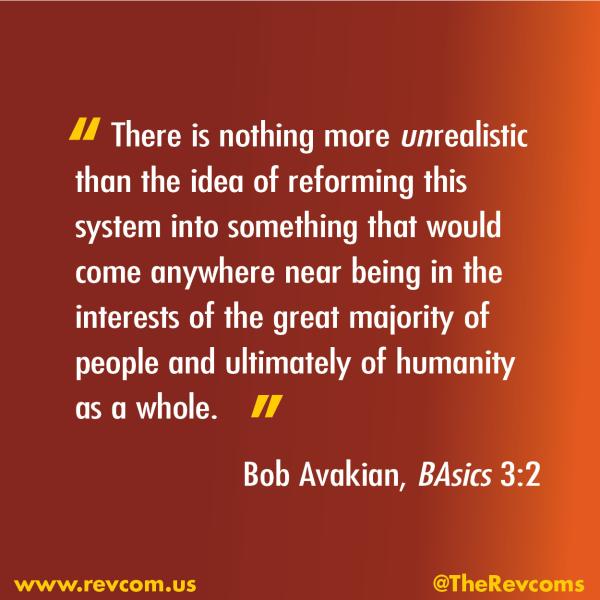
But under the system of capitalism, the well-being of the masses is an “externality” that is always subordinated to the drive for profit. And this is even more true in Turkey, a capitalist country under the fascist regime of Erdoğan and his Justice and Development Party (AKP). So it appears that none of these preparations were made—in fact, conscious decisions and policies that prioritized profit over safety were made (for example, see box on the “building boom” in Turkey).
Capitalism and Construction: Government Amnesty for Unsafe Buildings “Nets” Billions of Dollars, Thousands of Deaths
Erdoğan and the AKP actually came to power in large part because of mass anger at the previous government’s handling of the 1999 earthquake. And he made a big deal about builders being held accountable for lost lives, having “blood on their hands” and so on.
This was clearly for demagogic purposes only. The AKP itself promoted a massive building boom that was highly profitable to investors in construction and that stimulated the economy broadly, strengthening the capitalist class and further building up Turkey in Erdoğan’s dream image of a “Great Power.” As part of this, the AKP looked the other way at corner-cutting by construction companies and the failure of authorities to enforce building codes. As of 2018, it was reported that half the buildings in Turkey—almost 13 million—were built in violation of codes.
So how did the AKP deal with that? That same year, the government declared an amnesty for such buildings—providing official “certification” of unsafe buildings in exchange for a fee.
These fees netted the government $3 billion. What the masses “netted” was senseless death. As the chairman of the Chamber of Civil Engineers said in 2019, the amnesty “will mean transforming our cities … into graveyards and result in coffins emerging from our homes. Whether it is completely unlicensed, or has more floors than the original plan, they gave an amnesty to all buildings. This is very dangerous.” A seismology expert examining photos of the collapsed buildings in this most recent quake said, “It is evident that most of them were not designed to withstand very strong earthquakes.” This was echoed by many other experts.4
Syria: Already Ripped to Shreds by the Wolves of Imperialism, Now Abandoned in the Face of Natural Disaster
Capitalism-imperialism—the system that dominates the whole planet and “organizes” everything around the accumulation of further wealth and power of the major imperialist countries—leads to tremendous geographic inequality. Wealth and technology are concentrated in a few countries and some regions. In those places, the benefits of this wealth trickle down to some degree to the entire population. In other areas—in most of the world!—people are born into a life of bitter poverty and exploitation, brutal dictatorships, and devastating wars.
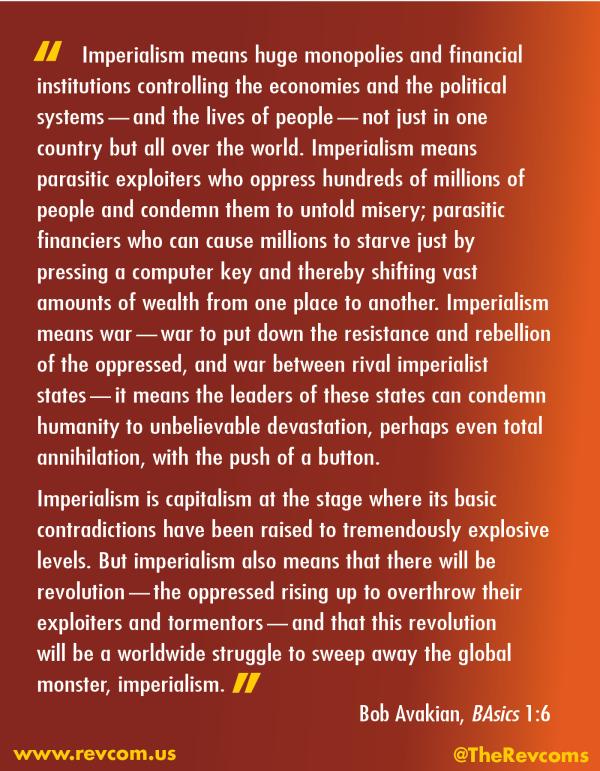
This is marked even within Turkey. The earthquake hit in the south, considered “one of the country’s poorest and least developed regions,” far from the financial, industrial and tourist areas of Turkey. And part of the affected area is in North Kurdistan (the portion of Kurdistan that is in Turkey). The Kurdish people are a bitterly oppressed minority nationality in Turkey as well as in Syria, Iran, and Iraq. The Kurdish region not only suffers from neglect and poverty, but also from repeated military attacks by the Turkish government. So these are areas with less resources to begin with, and harder to reach from the more developed areas.
But the situation in Syria before the earthquake was even worse—because of a civil war that has been going on since 2011 (see box). Because there is little media coverage, the mass suffering and death has been largely unnoticed by the rest of the world.
Syria—Already Ripped to Shreds by Reactionary Proxy War
A civil war has been raging in Syria since 2011. This war began as a mass popular movement against the hated regime of Bashar al-Assad (an ally of the Russian imperialists, who are one of U.S. imperialism’s main rivals). But it soon turned into a proxy war between the U.S., Russia and other imperialist and reactionary powers. Russia backed the Assad government, while the U.S. backed a variety of “rebel” groups—including jihadists. At the same time, other reactionary regional forces like Iran, Turkey, Saudi Arabia, Israel, and the Islamic jihadist fascist ISIS group all got in the mix.5 Different forces now control different parts of the country. Armed groups backed by Turkey actually control a significant part of the Syrian earthquake zone, while other affected areas are controlled by U.S.-backed and/or jihadist militias. Most of the country is still controlled by the Assad government, centered in the capital of Damascus.
Syria’s pre-war population was 22 million. Somewhere between 350,000 and a half million Syrians have been killed in the war, and more than half the population has had to flee their homes.6 Two million people are confined in refugee camps in Syria—many in the northern area where the quake hit; 3.6 million escaped across the border to Turkey and are either in refugee camps or nearby cities.
According to the UN, of the 4.5 million people living in the Idlib area of Syria hard hit by the earthquake, 2.9 million had been displaced from other parts of the country, and 90 percent already needed humanitarian aid before the quake hit. Now their needs are even greater, far outstripping the resources of agencies.
A member of a local aid group told the Washington Post, “It has been 12 years of us asking for help, calling on people who have discarded us as we died in front of their eyes. And during this huge unfortunate humanitarian crisis, the world has turned its back on us, as if there aren’t human beings in this area, as if there are no souls [here].”
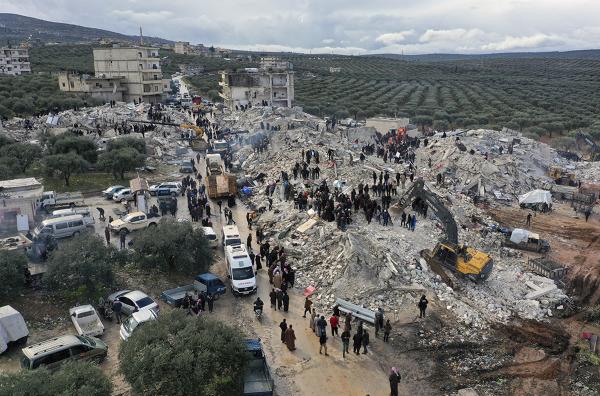
Earthquake left vast area of collapsed buildings in Syria near border with Turkey, February 6, 2023. Photo: AP
On top of this, the imperialist contention over control of Syria, and specifically the fact that different powers control different parts of the country, has led to sharp restrictions on aid shipments. Over the years, Assad’s imperialist patron (Russia) has insisted at the UN that any aid to displaced people come through Damascus, Assad’s seat of power. This would give Assad leverage over the parts of Syria he doesn’t control, including much of the earthquake zone.
On the other hand, the U.S. has imposed strict sanctions on the Damascus government—sanctions that punish other countries that trade with Syria. As a result, only a few countries like Russia and Iran can send aid to Damascus, and the only way to get aid to the anti-Assad areas in the north is through a single border crossing from southern Turkey. And even that crossing was closed for several days after the quake, apparently due to damage to the roads in the area. The first aid shipment only arrived there on Thursday, more than three days after the quake hit.
For these powers, the ability to feed—or to starve—displaced people is a question of gaining political/military advantage, not “humanitarianism.”
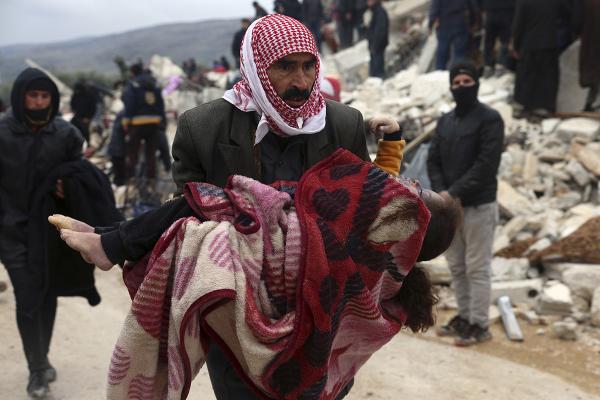
Man carries body of victim of 7.8 earthquake near border of Syria and Turkey, February 6, 2023. Photo: AP
Conclusion
The Turkey/Syria earthquake is one of those powerful forces of nature that have always confronted humanity—and under any kind of system, a quake of this magnitude would undoubtedly bring tragedy and suffering. But the unmitigated catastrophe here—the source of so much of the suffering and death—is not a natural disaster, but the disastrous system of capitalism-imperialism. Under this system, human beings (and the rest of nature, for that matter) are viewed through the lens of profit and power. The complete failure of this system to prepare for or properly respond to this massive, yet not “unexpected,” earthquake—and the dire situation of the people even before this disaster hit—is yet one more screaming message to us that we need REVOLUTION, and a whole new system, if humanity is going to survive and flourish on this planet.
February 19 update continued:
The Turkish government now estimates that “84,700 buildings have collapsed or are severely damaged,” and that 345,000 apartments were destroyed. The number of homeless is in the millions, including many people who were living in refugee camps to begin with.
Faced with mounting public anger at the collapse of thousands of supposedly “earthquake-proofed” buildings, and the extremely slow government response to the disaster, Turkey’s fascist regime is looking for scapegoats. This week it declared that it is “investigating” 246 “suspects” that it says are responsible for the building collapses. Missing from the “suspect list” is the government itself, which promoted a reckless building boom, looked the other way at code violations, and openly “certified” buildings as “safe” in return for payment of a fee.
In Syria, the situation for millions is even more desperate. Only a pittance of aid has arrived—as of February 18, 178 UN trucks had come into Syria from Turkey to meet the needs of millions. Much of the problem flows from the proxy war among rival imperialists (the U.S./UK and Russia) and regional powers (Turkey, Saudi Arabia and Israel) over control of Syria. Syria is now divided up into different areas under the control of different powers, each more concerned with undermining the other than with providing humanitarian relief.
One sharp example of this: Immediately after the earthquake the U.S. announced it would not suspend crippling economic sanctions aimed at weakening the Assad regime in Damascus. According to the Carter Center7, these sanctions “amount to an embargo on almost all trade and financial ties between the U.S. and Syria,” including the import of machinery needed to excavate crushed buildings, and the fuel to run those machines. They even prevent Syrians living abroad from sending money home to their families.
This is a major obstacle to the rapid mobilization of a massive relief effort that is needed. But while it has made some minor adjustments, basically the U.S. is sticking to this position.
Last week we wrote that everything about the way this system prepared for and responded to this natural disaster screams out with “the need for REVOLUTION, and a whole new system, if humanity is going to survive and flourish on this planet.” As the days go by, that urgency is screaming ever louder.
NEWS FLASH: Incredibly, early on February 19, in the midst of the humanitarian emergency caused by the earthquake, Israel launched a missile strike on Damascus, the capital city of Syria, killing five people and damaging several civilian buildings in the densely populated center of the city! As we post this update, Israel has not made any comment or attempted to justify this blatant war crime.
[ Return to top ]
